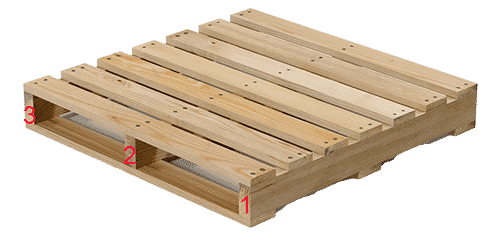
Block Pallets
These pallets are known for their four-way entry, meaning they can be accessed by forklifts on all four sides. Block pallets can be made of wood, plastic, plywood and are generally comprised of four to 12 cylindrical wooden posts to stabilize the top deck boards. Block pallets are available with or without bottom boards, and can come in a variety of configurations. This design uses both perpendicular and parallel stringers to increase handling efficiency.
String Pallets
Two -way stringer pallets: This pallet gets its name from the stringers- the boards running between the top and bottom deck boards-used to support the pallet’s load. The two-way pallet allows fork entry from only two sides.
Four-way stringer pallets: This types of pallet is exactly the same as its two-way counterpart, but allows access on four sides. There are two types of four-way stringer pallets: those with notched stringers and those with block designs.


Double-Face Pallet
Pallets exist in two general styles: single-face and double-face. Double-face pallets are comprised of decks on both top and bottom surfaces. the bottom deck increases the strength of the pallet, and helps evenly distribute the weight of the load .
Double-face pallets come in two types: reversible and non-reversible. reversible pallets can be flipped and have items stacked on either side. non-reversible pallets generally have one surface with more densely packed planks for storing and packing.
Double Wing Pallet
This pallet’s design consists of top and bottom deck boards extending beyond the stringers or stringer boards. This design gives the illusion of “wings” along the side of pallets,


Solid Deck Pallet
The surface of solid deck pallets consist of one large sheet of wood with no spaces. These pallets are considered aesthetically appealing to many customers, and are easy to clean and transport.

